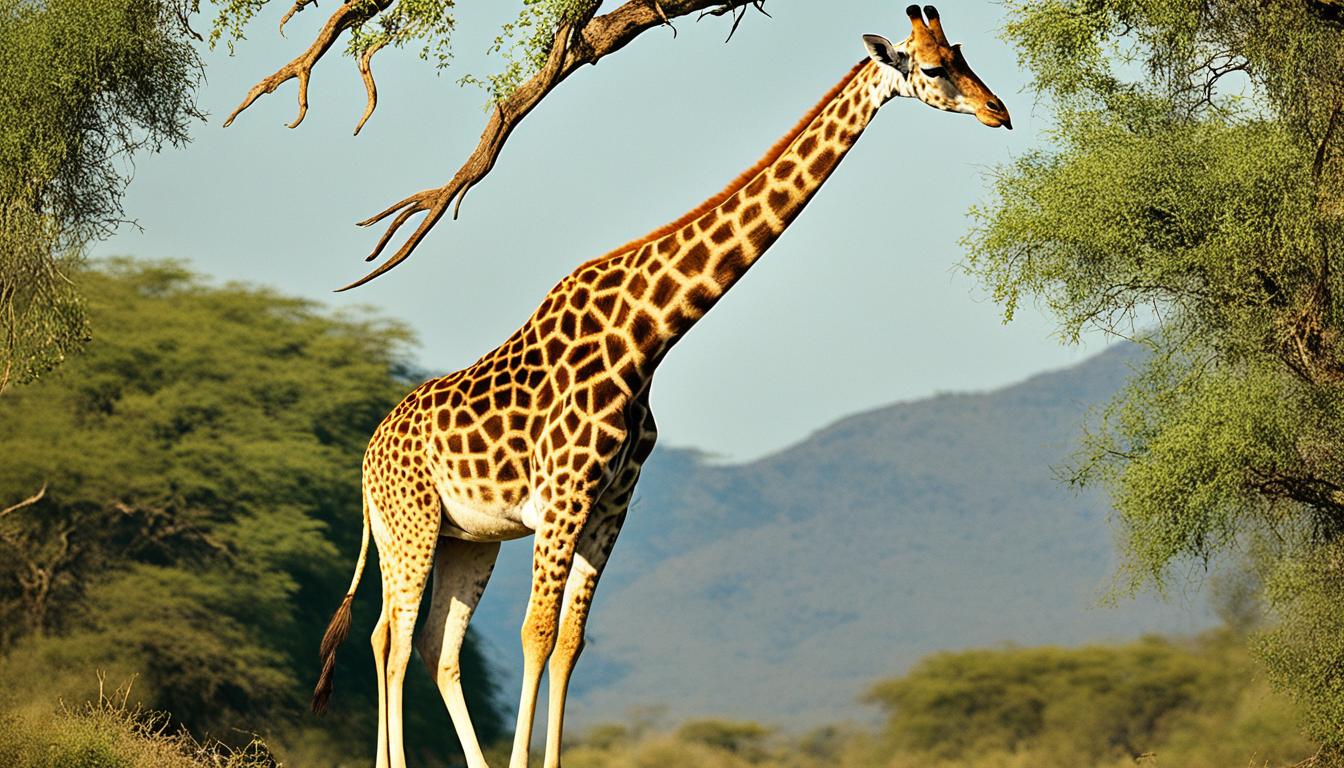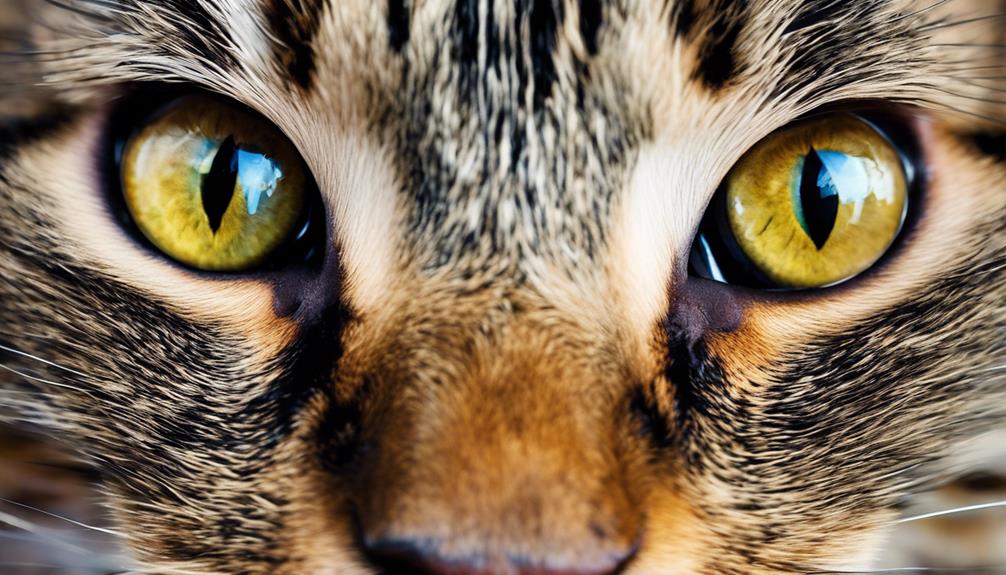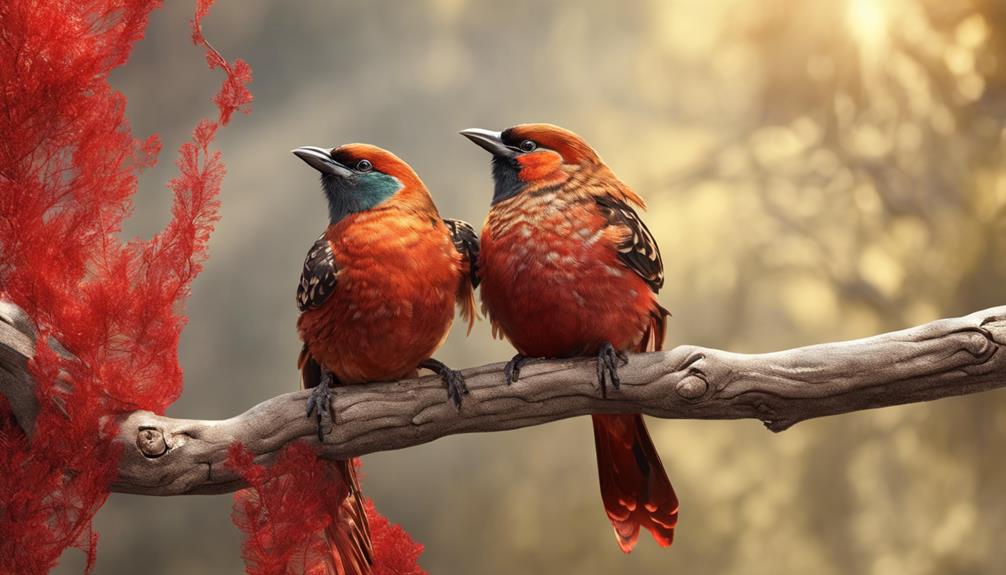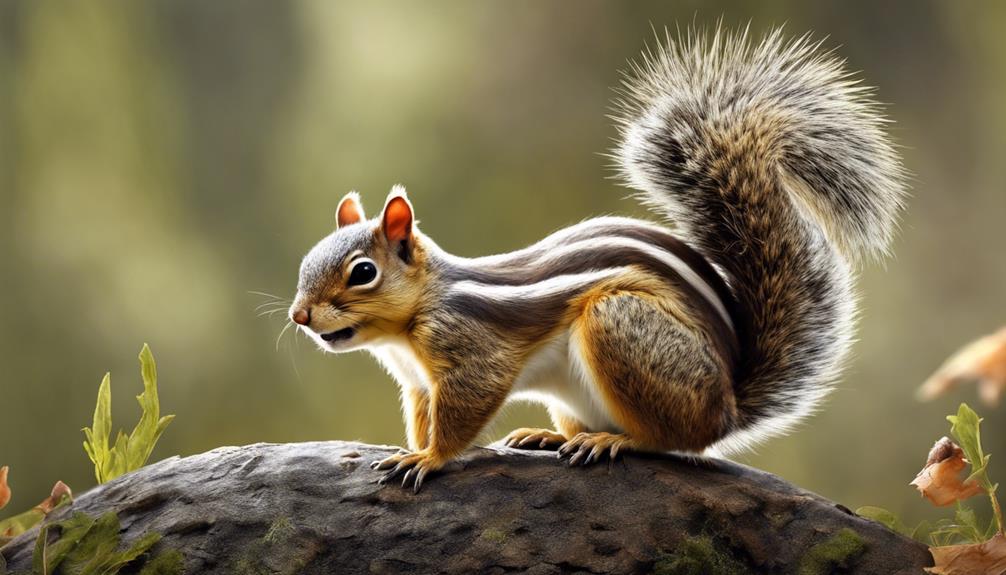Do you realize that there are multiple intriguing creatures that start with the letter N? From tiny worms to magnificent mammals, these animals highlight the amazing variety of the natural world. Come along on a quest to uncover some of the most captivating animals that start with N!
Key Takeaways:
- Animals that start with N encompass a wide range of species, including mammals, birds, fish, and invertebrates.
- Some notable animals that start with N include the nocturnal nightingale, the regenerating newt, and the adaptable Norwegian rat.
- These animals possess unique characteristics and adaptations that enable them to thrive in their respective habitats.
- Learning about animals that start with N provides a deeper appreciation for the incredible diversity of wildlife and the wonders of the natural world.
- Stay tuned as we explore each of these fascinating creatures in more detail!
List of Common Animals That Start With Letter N
This section provides a list of common animals that start with the letter N. From the amphibious newt to the nocturnal nightingale, these animals span different categories and habitats, showcasing their unique traits and behaviors. Whether you’re looking to expand your knowledge or engage young learners, this list is a valuable resource.
Common Animals That Start With N
- Newt
- Nuthatch
- Nightingale
- Numbat
- Nyala
- Nematode
- Nase
- Napu
- Norwegian Rat
- Nicator
- Noodlefish
- Nalolo
- Nightcrawler
Explore the fascinating world of these common animals that start with the letter N. Discover the unique adaptations, habitats, and behaviors that make them truly remarkable. Each animal has its own story to tell, showcasing the diversity and beauty of the natural world.
| Animal | Habitat | Notable Features |
|---|---|---|
| Newt | Aquatic and terrestrial environments | Amphibious nature, ability to regenerate lost body parts |
| Nuthatch | Wooded areas | Unique ability to climb down trees headfirst |
| Nightingale | Various habitats | Melodic nocturnal song |
| Numbat | Australian woodlands | Termites as their primary food source |
| Nyala | Southern Africa | Distinct body markings, spiral horns in males |
| Nematode | Diverse environments | Microscopic roundworms, abundant in soil and oceans |
| Nase | European rivers | Adapted to fast-flowing streams, flattened body shape |
| Napu | Southeast Asian forests | Sharp fangs for defense, lesser mouse-deer |
| Norwegian Rat | Global distribution, often near human populations | Highly adaptable, common brown rat |
| Nicator | African forests | Loud and varied calls, dominant behavior |
| Noodlefish | North Pacific | Slender fish with noodle-like appearance |
| Nalolo | Indian Ocean | Gender-changing wrasse fish |
| Nightcrawler | Soil and compost | Large earthworms, commonly used as fishing bait |
Newt
Newts are small amphibians that belong to the salamander family. These fascinating creatures have a unique life cycle, spending part of their lives in water and part on land. They have a slender body, smooth skin, and a distinct tail that helps them navigate through water. Newts can be found in various habitats, including forests, ponds, and wetlands.
One of the most remarkable traits of newts is their ability to regenerate lost body parts. If a newt loses a limb, it has the incredible capability to regrow it. This regenerative power extends beyond limbs and includes other body parts such as heart tissues and even parts of their eyes. This remarkable ability makes newts one of the most fascinating creatures in the animal kingdom.
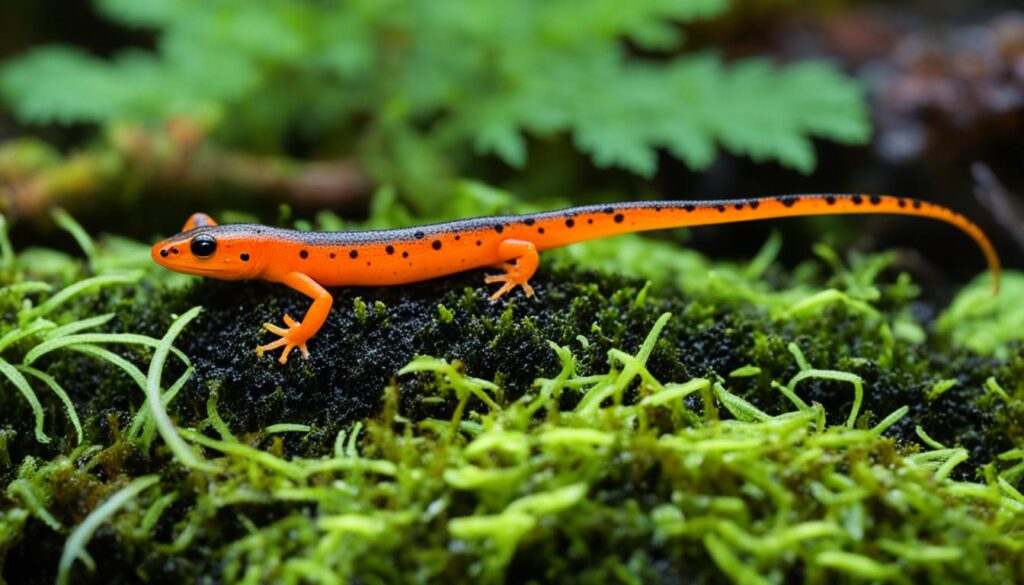
“Newts are fascinating creatures with the unique ability to regenerate lost body parts.”
Life Cycle of a Newt
Newts undergo a complex life cycle that involves distinct stages and transformations. It begins with the hatching of eggs in aquatic environments, where larvae develop and spend their early days as aquatic creatures. During this stage, they have gills for breathing and a tail that helps them swim.
As the larvae grow and develop, they undergo a remarkable metamorphosis known as “eft” stage. In this stage, they develop lungs, lose their gills, and begin to venture onto land. Efts have vibrant colors, ranging from bright orange to yellow or green, which serve as a warning to predators that they are toxic.
After spending a few years on land as efts, they transform into adult newts. Adult newts have fully developed lungs and spend most of their time in water, although they may come onto land during certain seasons, such as mating season. They are known for their distinctive mating rituals, which involve elaborate displays and courtship dances.
Newt Species
There are several species of newts, each with its unique characteristics. Here are a few notable examples:
| Newt Species | Habitat | Distinct Features |
|---|---|---|
| Eastern Newt | Eastern North America | Can change color depending on their surroundings |
| Palmate Newt | Europe | Distinctive black webbing between their hind toes |
| Japanese Fire-Bellied Newt | Japan and China | Has bright red or orange markings on its belly |
Whether it’s their ability to regenerate body parts or their unique life cycle, newts are truly remarkable creatures that continue to captivate nature enthusiasts and scientists alike.
Nuthatch
The nuthatch is a small songbird that stands out from the crowd with its exceptional ability to climb down trees headfirst. While most birds can only climb up, nuthatches possess the remarkable talent of descending tree trunks in search of food. This distinctive behavior sets them apart and makes them fascinating creatures to observe in the wild.
“Nuthatches demonstrate incredible agility as they navigate tree bark in a reverse orientation,” says ornithologist Dr. Amanda Johnson. “This adaptation allows them to access food sources that other birds cannot reach.”
With their short, sturdy legs and strong toes, nuthatches effortlessly maneuver upside down, thanks to an adaptation known as a “reversed hind-toe.” This physical trait gives them an advantage in finding insect larvae and hidden seeds tucked away in bark crevices.
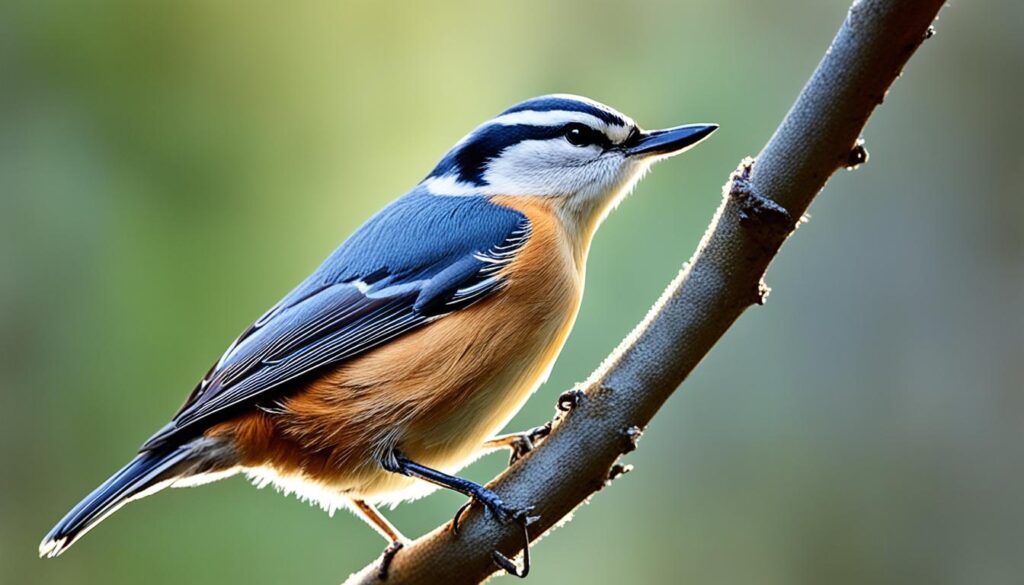
Contrary to their name, nuthatches don’t hatch nuts, but they do have a clever way of opening them. These resourceful birds wedge nuts into tree bark and then use their sharp bills to pry them open, revealing the tasty morsels inside. This unique feeding behavior earned them their distinctive moniker.
Types of Nuthatches
There are several species of nuthatches found around the world, each with its own characteristics and habitat preferences. Some notable species include:
- White-breasted nuthatch: This common North American species sports a vibrant white chest and a distinct black cap on its head.
- Red-breasted nuthatch: With its rusty-colored breast and bold black stripe across the eye, this species is a favorite among birdwatchers.
- Pygmy nuthatch: Found in western North America, these tiny nuthatches are highly social and travel in noisy flocks.
The Nuthatch’s Melodic Song
Although nuthatches are small birds, they boast a surprisingly powerful voice. Their songs are a symphony of whistles, trills, and bursts of melodious notes. These vocalizations are not only used for communication but also aid in defending territories and attracting mates.
Dr. Johnson explains, “Male nuthatches often serenade potential mates with their elaborate songs, showcasing their vocal prowess and ability to provide for a family.”
Conservation Status
Most species of nuthatches are relatively common and not currently considered to be at risk. However, habitat loss and fragmentation can pose challenges for these birds, particularly those reliant on specific forest ecosystems. Ongoing conservation efforts are crucial in maintaining healthy populations of nuthatches and preserving their unique behaviors in the wild.
| Nuthatch Species | Habitat | Conservation Status |
|---|---|---|
| White-breasted nuthatch | Deciduous and mixed forests of North America | Least Concern |
| Red-breasted nuthatch | Coniferous forests of North America | Least Concern |
| Pygmy nuthatch | Western pine forests of North America | Least Concern |
Nightingale
The nightingale, known for its melodic and powerful nocturnal song, captures the hearts of many with its captivating music. Males primarily sing these enchanting melodies to attract females. It’s fascinating to note that nightingales earned their name due to their propensity for serenading not only during the day but also throughout the night.
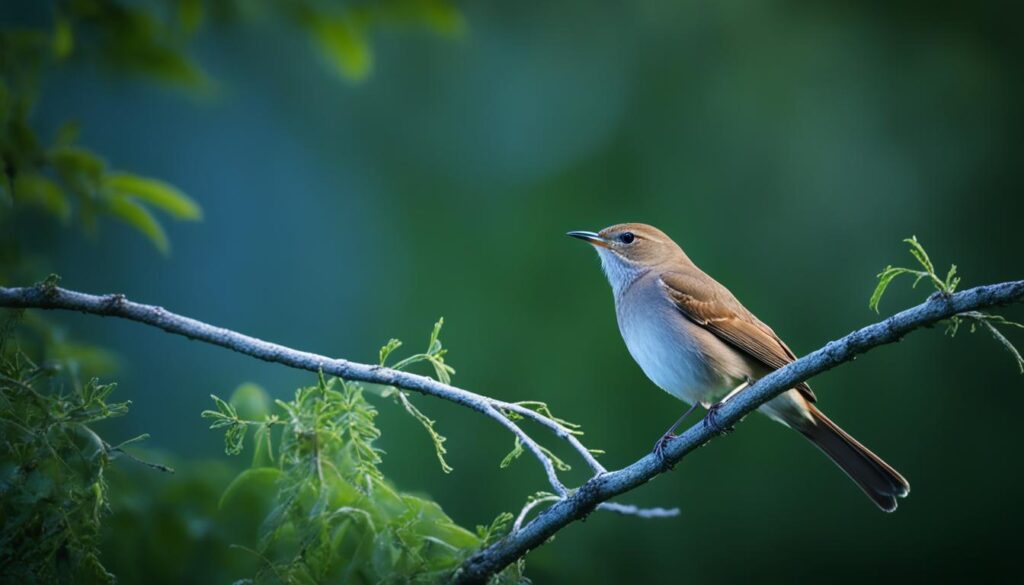
“The nightingale’s song is a testament to the beauty and harmony that nature offers. Its melodic notes echo through the darkness, enchanting all who listen.”
The Nocturnal Virtuosos
Nightingales are celebrated for their exceptional musical ability, which is most pronounced during the moonlit hours. Their captivating tunes fill the night air, blending with the tranquil ambiance of the nocturnal world. Their melodies create a symphony that resonates deeply with the listeners, evoking a sense of calm and wonder.
Magical Moments under the Stars
Imagine strolling through a moonlit garden, surrounded by the sweet scent of flowers, while the nightingale perches nearby, filling the silence with its magical song. The nocturnal serenade of the nightingale has inspired poets, artists, and lovers throughout history, evoking a sense of romance and connection to the natural world.
| Nightingale | Features |
|---|---|
| Scientific Name | Luscinia megarhynchos |
| Habitat | Woodlands, gardens, and parklands |
| Diet | Insects, worms, and berries |
| Size | Approximately 6-7 inches (15-18 cm) in length |
| Unique Fact | Nightingales can produce over 1,000 different song variations |
Numbat
The numbat is a small marsupial native to Australia. It is also known as the banded anteater due to its distinctive striped pattern. Despite its name, the numbat does not resemble traditional marsupials; instead, it bears a closer resemblance to squirrels or chipmunks. With its slender body, bushy tail, and pointed snout, the numbat is a unique and intriguing creature.
One of the most fascinating aspects of the numbat is its diet. This marsupial is a dedicated termite feeder, relying almost exclusively on termites for sustenance. In fact, it can consume up to 20,000 termites in a single day! The numbat’s method of capturing termites is equally intriguing. It uses its long, sticky tongue (which can extend up to 10 centimeters) to extract the insects from their underground tunnels.
The Numbat’s Adaptations
Unlike other marsupials, the numbat lacks a pouch for carrying its young. Instead, the female numbat constructs a nest made of fine grasses to provide a safe and cozy environment for her offspring. The young numbats, called joeys, stay in the nest until they are fully furred and able to venture out on their own.
The numbat is a testament to the marvels of evolution, with its specialized adaptations for termite feeding and survival in the Australian habitat. Its slender body, sharp claws for digging, and long tongue are all finely tuned for a life centered around termites.
The numbat population faces challenges due to habitat loss and predation by introduced species such as foxes and cats. Efforts are being made to conserve and protect this unique marsupial through initiatives such as habitat restoration and predator control programs.
By learning about and appreciating the numbat, we gain a greater understanding of the intricate web of life and the importance of preserving biodiversity.
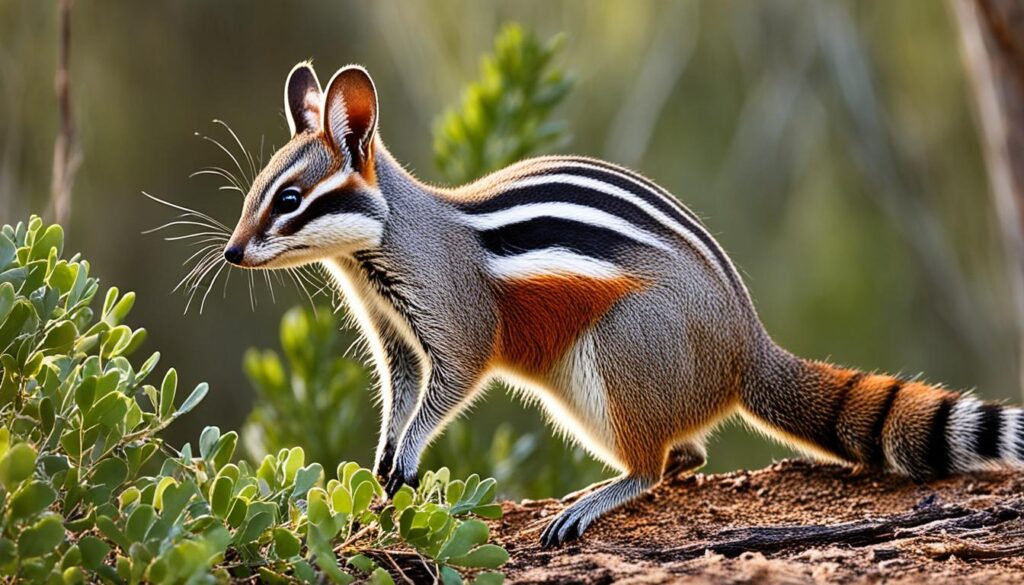
Nyala
The nyala is a beautiful antelope native to southern Africa. With its distinct body markings and spiral horns, the nyala is easily recognized in its natural habitat. Female nyalas have a warm orange or brown coat and lack horns, while males are darker and sport prominent spiral horns.
This antelope species is found in the dense woodlands of southern Africa, particularly in countries like South Africa, Mozambique, and Zimbabwe. Its habitat preference allows it to thrive in areas with abundant vegetation and water sources.
The nyala is a browser, meaning it primarily feeds on leaves, fruits, and other plant materials. It has a specialized digestive system that allows it to extract essential nutrients from the vegetation it consumes. This diet makes the nyala an important contributor to the ecosystem by helping to disperse seeds and control plant growth.
In addition to its striking physical appearance, the nyala has an intriguing social structure. Males are generally solitary or form small bachelor groups, while females and their offspring live in herds. During mating season, dominant males engage in fierce battles to establish their territory and breeding rights.
Key Features of Nyala:
- Distinct body markings
- Spiral horns in males
- Warm orange/brown coat in females
- Prevalent in southern Africa
- Browser diet of leaves and fruits
- Social structure with solitary males and herds of females
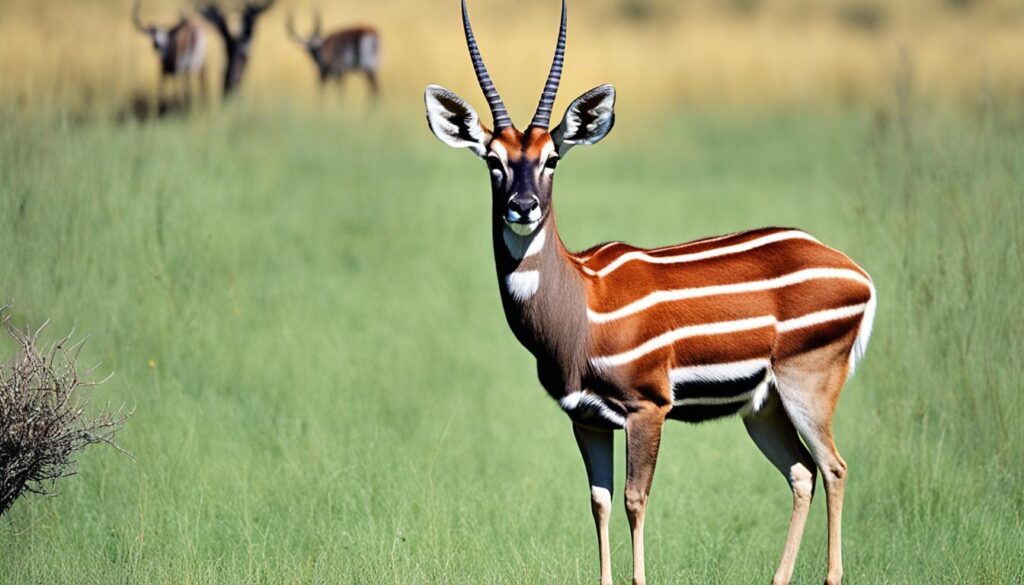
| Scientific Name | Tragelaphus angasii |
|---|---|
| Conservation Status | Least Concern |
| Habitat | Dense woodlands |
| Location | Southern Africa |
| Diet | Herbivorous (browsing on leaves, fruits, and plant materials) |
| Weight | Female: 120-240 lbs (55-110 kg) | Male: 220-280 lbs (100-125 kg) |
| Length | Female: 4-5 ft (1.2-1.5 m) | Male: 5-6 ft (1.5-1.8 m) |
Nematode
Nematodes, also known as roundworms, are microscopic worms that can be found in various environments, from soil to oceans. They are incredibly diverse and have adapted to survive in almost every habitat on Earth. These tiny creatures play vital ecological roles and have both beneficial and detrimental effects on plants, animals, and humans.
Nematodes are characterized by their slender, cylindrical bodies and pointed ends. Despite their small size, nematodes are incredibly abundant and widespread. In fact, scientists estimate that four out of every five animals on Earth are nematodes! Due to their ubiquity, nematodes are considered one of the most successful animal groups on the planet.
Some nematodes are parasitic, while others are free-living. Parasitic nematodes can infect plants, animals, and even humans, causing various diseases and health issues. They can harm crops, livestock, and humans alike, making them a significant concern in agriculture, veterinary medicine, and public health.
Roundworms come in a wide range of shapes and sizes. Some are barely visible to the naked eye, while others can reach several meters in length. Their diversity is truly remarkable, with nematodes occupying almost every ecological niche imaginable. They can be found in freshwater habitats, ocean sediments, soil, and even inside the bodies of other organisms.
Despite their tiny size, nematodes play crucial roles in ecosystems. They contribute to nutrient cycling, as some species feed on decaying organic matter and help break it down. Other nematodes are important predators, preying on bacteria, fungi, and other microscopic organisms. Their activities help maintain the balance of microbial communities and influence the overall health of ecosystems.
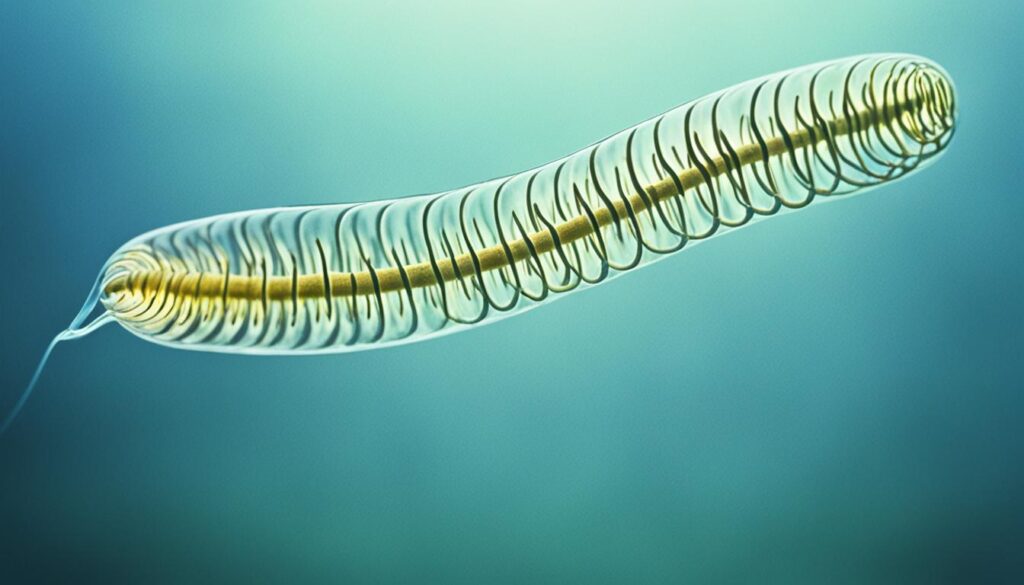
Nase
The nase is a freshwater fish commonly found in the rivers of Europe. With its flattened body and strong swimming abilities, the nase has successfully adapted to life in fast-flowing streams.
Known for its sleek and streamlined shape, the nase is built for navigating through swift currents. Its body structure allows it to minimize drag and maintain stability while swimming. The nase also possesses a powerful caudal fin, which enables it to propel itself with speed and agility.
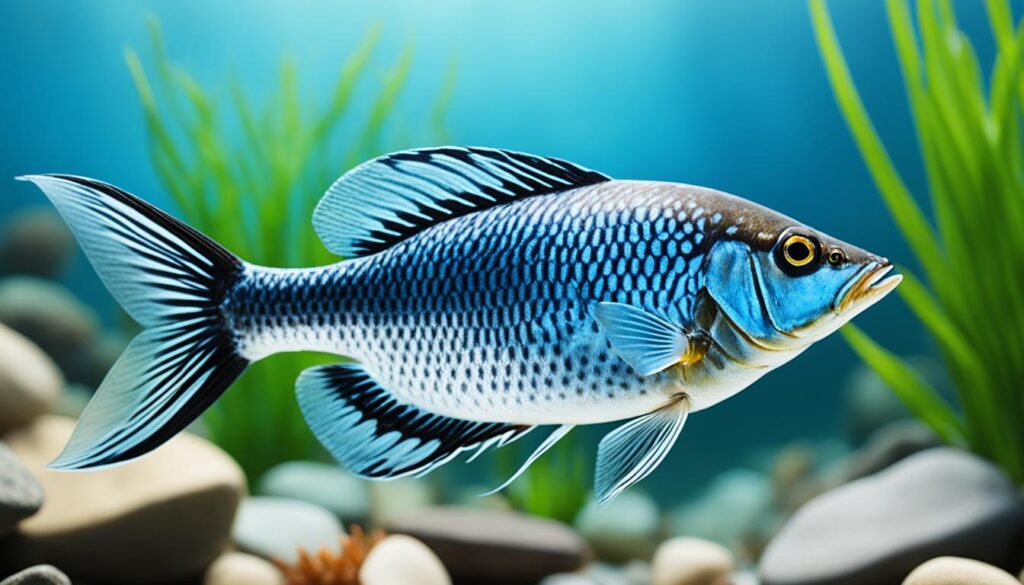
In addition to its physical adaptations, the nase has developed specialized feeding habits to thrive in its environment. It primarily feeds on small invertebrates, algae, and other plant matter found in the rivers of Europe.
The nase plays a significant ecological role in freshwater ecosystems, contributing to the balance of populations and food webs. This species serves as both predator and prey, interacting with various organisms in its habitat.
Understanding the biology and behavior of the nase is crucial for the conservation of freshwater ecosystems in Europe. By studying its adaptations and ecological interactions, scientists can develop strategies to preserve the nase and the delicate balance of the rivers it inhabits.
Overall, the nase is a remarkable freshwater fish that showcases nature’s ability to adapt and thrive in diverse environments. Its presence in European rivers is not only a testament to its resilience but also a reminder of the rich biodiversity found across the continent.
Napu
The napu, also known as the lesser mouse-deer, is a small hoofed mammal found in Southeast Asia. Despite their tiny size, they are known to stand their ground and use their sharp fangs in defense against threats.
The napu, scientifically known as Tragulus napu, belongs to the family Tragulidae. These fascinating creatures are native to the dense forests and swampy areas of Southeast Asia, including countries like Indonesia, Malaysia, and Thailand.
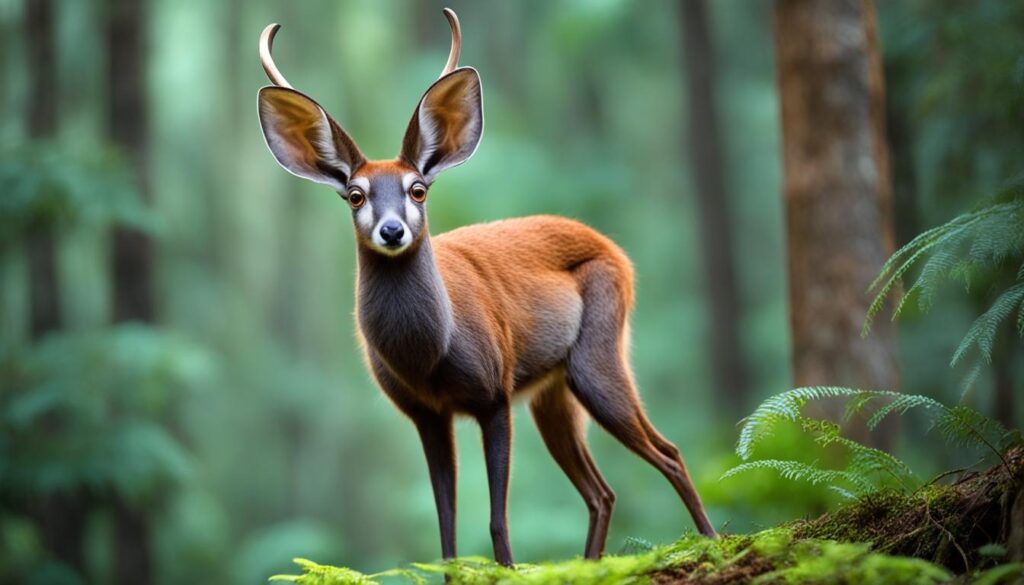
With a height of only about 40-45 centimeters and weighing around 5-8 kilograms, napus are one of the smallest hoofed mammals in the world. Their compact body and delicate limbs allow them to maneuver effortlessly through the dense foliage of their habitat.
The napu is recognized for its slender, deer-like body, pointed snout, and large, round eyes. Its fur varies in color, ranging from reddish-brown to gray or dark brown, providing excellent camouflage within its natural surroundings.
These remarkable creatures are predominantly herbivorous, feeding on a variety of leaves, grasses, shoots, and fruits. Due to their smaller size, napus have the advantage of being able to access lower vegetation that larger herbivores cannot reach.
The lesser mouse-deer is primarily a solitary creature, coming together only during mating season. Females give birth to a single offspring after a gestation period of about six months. The young napu, known as fawn, is precocial, meaning it is capable of walking and running shortly after birth.
The napu’s survival is threatened by habitat loss and fragmentation due to human encroachment and deforestation. Conservation efforts are in place to protect their natural habitats and ensure their survival in the wild.
Norwegian Rat
The Norwegian rat, also known as the brown rat, is one of the most widespread rat species globally. These rats are highly adaptable and are often found living near human populations.
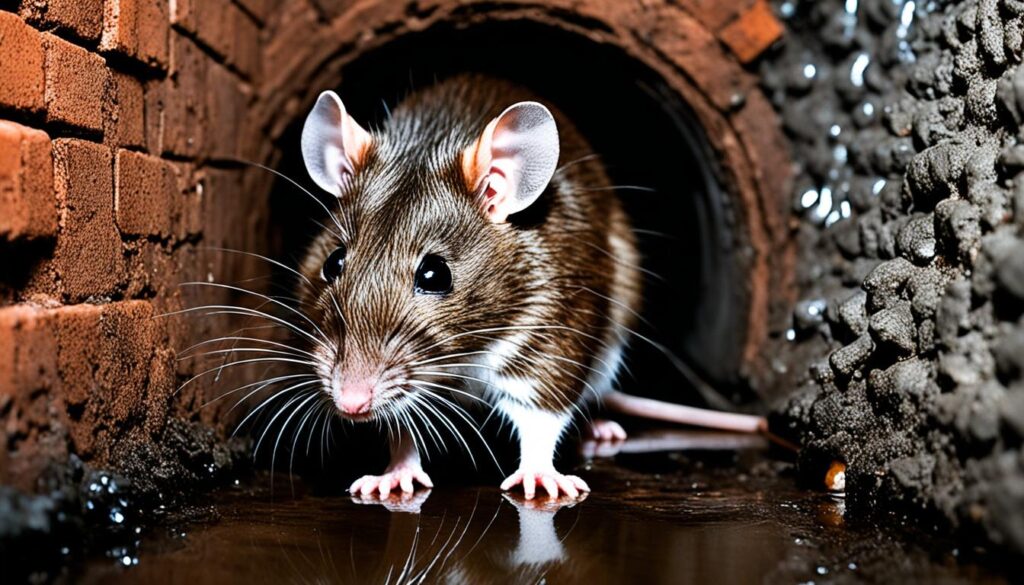
Key Characteristics of the Norwegian Rat:
- Color: Brown
- Size: Up to 10 inches in length
- Weight: Can weigh between 11 to 18 ounces
- Tail: Typically shorter than the head and body length
- Habitat: Found in urban and rural areas
- Adaptability: Thrives in various environments and climates
“The Norwegian rat, with its adaptability and ability to coexist with humans, has earned its reputation as a resilient and agile survivor.” – RatExpert22
Distribution of the Norwegian Rat:
The Norwegian rat is native to northern China and Mongolia but has since spread to all continents except Antarctica. It has successfully colonized urban areas around the world, thriving in environments where it can scavenge for food and find shelter. These rats are particularly common in large cities and areas with dense human populations.
Impacts on Humans:
The adaptability of the Norwegian rat poses various challenges for humans. They are known to cause damage to buildings, contaminate food supplies, and spread diseases through their droppings and parasites. In agricultural settings, they can destroy crops and stored grain.
Efforts to Control the Norwegian Rat:
Due to the negative impacts of the Norwegian rat, efforts have been made to control their populations. Pest control methods often include the use of traps, bait stations, and rodenticides. Public education campaigns emphasizing proper waste disposal and sanitation practices also play a crucial role in preventing rat infestations.
Rat Fact vs. Fiction:
| Fact | Fiction |
|---|---|
| 1. Norwegian rats are excellent swimmers. | 1. Rats can chew through concrete walls. |
| 2. They are social animals, living in colonies. | 2. Rats are carriers of the bubonic plague. |
| 3. Norwegian rats have poor eyesight but a strong sense of smell. | 3. Rats are attracted to cheese. |
Nicator
Nicators are songbirds native to Africa. They are known for their loud and varied calls. Despite their pleasant songs, nicators can be aggressive and often dominate other birds in their habitat.
If you ever find yourself in Africa, keep your ears open for the enchanting melodies of the nicator. These talented songbirds have a unique ability to captivate listeners with their melodic tunes, filling the air with their rich and vibrant voices.
With their striking plumage and graceful movements, nicators are a true delight to observe in the wild. Their vibrant colors, ranging from deep blues to earthy browns, make them a visual spectacle against the African landscape.
One fascinating aspect of nicators is their ability to command attention through their calls. Their vocal repertoire consists of a wide range of sounds, each serving a different purpose. From melodic tunes that attract potential mates to territorial calls that assert dominance, nicators communicate their presence and intentions in distinct ways.
Although nicators are known for their harmonious songs, they can also exhibit a fierce side. These songbirds can be territorial and aggressive, especially when defending their nests or asserting dominance over other birds. Their assertive behavior allows them to maintain control over their preferred habitat, ensuring their survival in the competitive African ecosystem.
Notable Characteristics of Nicators
| Characteristic | Description |
|---|---|
| Geographical Range | Africa |
| Family | Nicatoridae |
| Habitat | Forests, woodlands, and savannas |
| Size | Varies depending on species, ranging from 15 to 23 centimeters in length |
| Diet | Insects, fruits, and seeds |
| Reproduction | Monogamous breeding pairs construct cup-shaped nests and raise their young together |
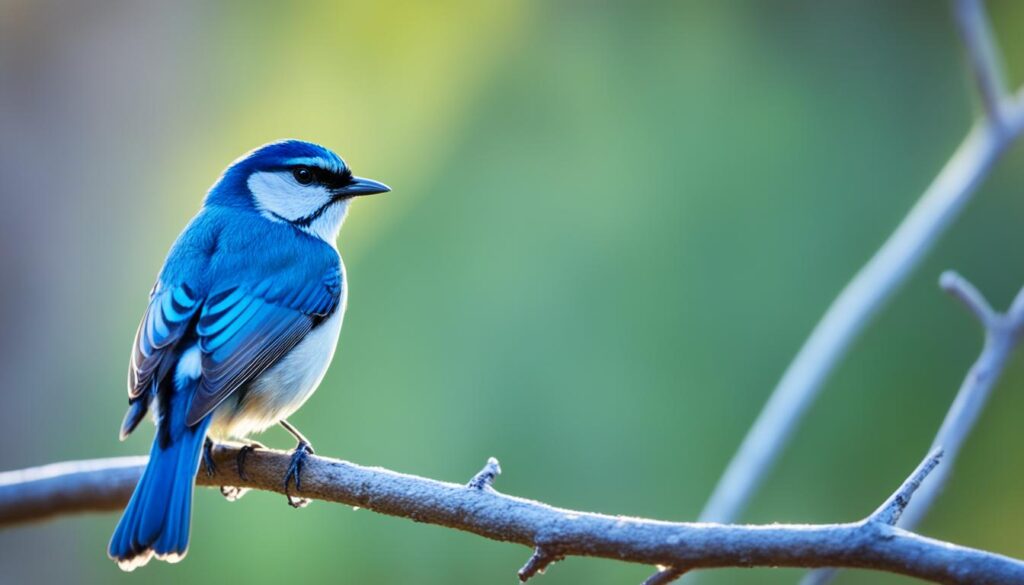
Despite their occasional aggression, nicators play a vital role in their ecosystem as pollinators and seed dispersers. Their feeding habits contribute to the health and diversity of African plant life, making them an essential part of the continent’s delicate balance of nature.
So, the next time you find yourself in the vast and diverse landscapes of Africa, take a moment to listen for the enchanting songs of the nicator. These melodious birds will surely leave an indelible mark on your heart and remind you of the incredible wonders that nature has to offer.
Noodlefish
The Noodlefish, also known as the Slender Fish, is a small species found in the North Pacific. These fish are known for their unique appearance and long, noodle-like bodies.
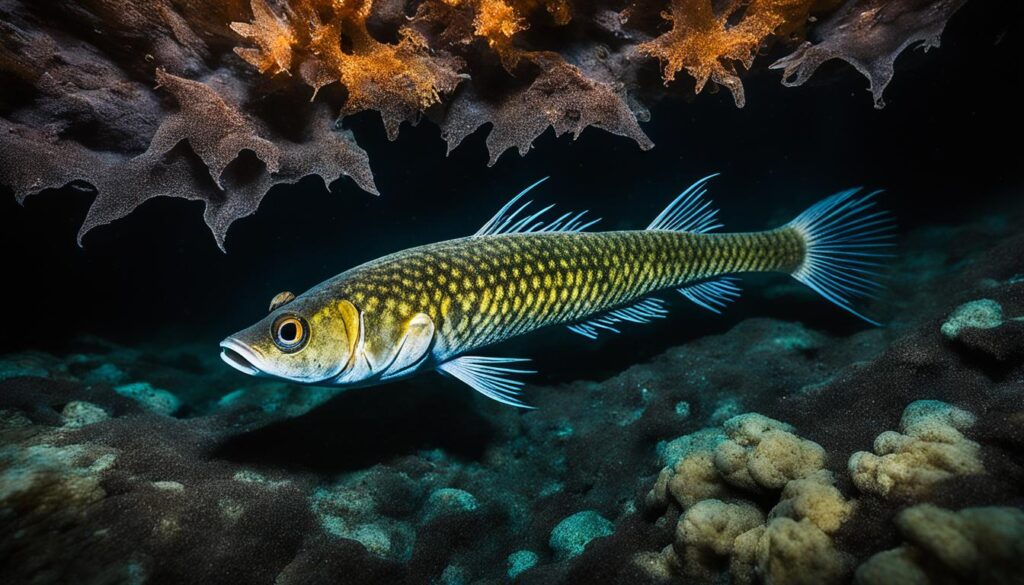
Despite their slender shape, Noodlefish are agile swimmers and are well adapted to their marine environment. They have streamlined bodies and powerful caudal fins that enable them to maneuver swiftly through the water.
Noodlefish primarily feed on small crustaceans, zooplankton, and other small marine organisms. Their elongated bodies and sharp teeth allow them to capture their prey with precision.
These fish are an important part of the North Pacific ecosystem, serving as a food source for larger predators and helping to maintain the balance of marine life.
Characteristics of the Noodlefish:
- Slender body shape
- Long, noodle-like appearance
- Powerful caudal fin for swimming
- Sharp teeth for capturing prey
It is fascinating to observe the Noodlefish in their natural habitat, gracefully gliding through the water with their unique body structure. Their distinct shape and behavior make them an intriguing species within the diverse marine ecosystem.
| Noodlefish Facts | |
|---|---|
| Habitat | North Pacific |
| Diet | Small crustaceans, zooplankton, marine organisms |
| Physical Characteristics | Slender body, long and noodle-like |
Nalolo
Nalolos are a type of wrasse fish mainly found in the Indian Ocean. They inhabit the vibrant coral reefs and tropical waters of this vast oceanic expanse. Nalolos are known for their vibrant colors and intricate patterns, making them a captivating sight for divers and snorkelers.
One fascinating aspect of nalolos is their ability to change their gender as they mature. They start their lives as females and then transition into males as they grow older. This unique reproductive strategy, known as sequential hermaphroditism, allows nalolos to optimize breeding opportunities within their social groups.
Their behavior and appearance also change as they undergo this gender transformation. Female nalolos typically have a vibrant orange or yellow coloration, while males exhibit more subdued hues of blue, green, and red. This color variation serves as a visual signal to potential mates and rivals within their ecosystem.
To showcase the beauty of nalolos, here is an image of these mesmerizing wrasse fish:
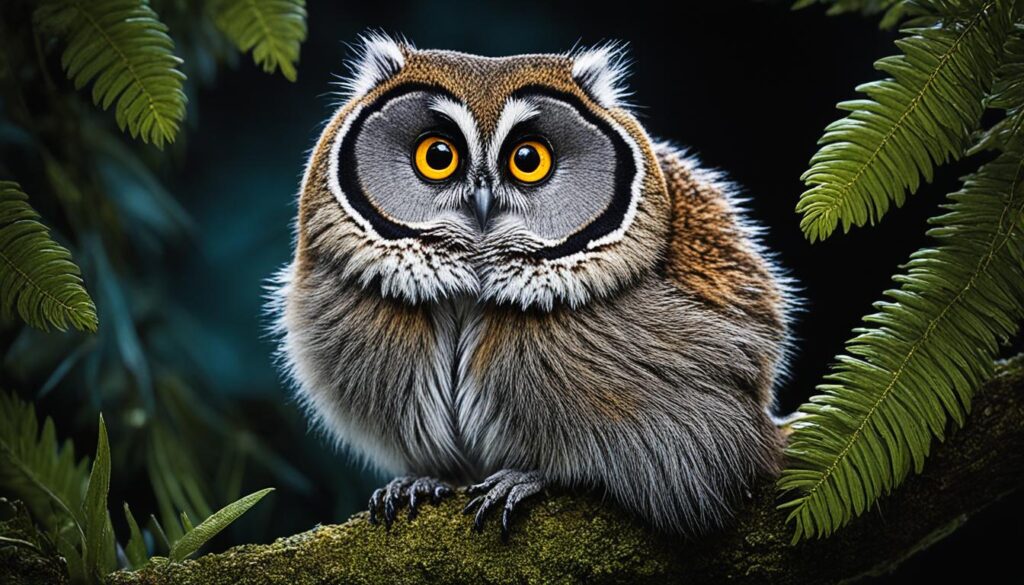
Nightcrawler
Nightcrawlers, also known as earthworms, are large and commonly used as bait for fishing. These slimy creatures are beneficial for anglers looking to attract a variety of fish species. With their wriggling movement and aroma, nightcrawlers entice fish to strike, making them a popular choice among fishermen and fisherwomen.

One of the fascinating facts about nightcrawlers is their voracious appetite. These earthworms have a remarkable ability to consume up to one-third of their body weight in a single day! This hearty appetite helps them break down organic matter in the soil, contributing to the natural cycle of decomposition and nutrient recycling.
When using nightcrawlers as bait, anglers typically thread them onto a fishing hook, allowing the worms to move naturally in the water, mimicking the behavior of potential prey for fish. Their soft and supple bodies make them an enticing target for various fish species, including bass, trout, and catfish.
Whether you’re an experienced angler or just starting out, nightcrawlers are an excellent choice as bait for fishing. Not only are they readily available, but their effectiveness in attracting fish makes them a trusted option for anglers worldwide.
Conclusion
Exploring animals that start with the letter N offers a fascinating glimpse into the diverse world of wildlife. From the unique adaptations of the naked mole rat to the melodic songs of the nightingale, each animal possesses its own remarkable traits and behaviors. By learning about these animals, we gain a deeper appreciation for the incredible diversity and beauty of the natural world.
From the small amphibious newt to the majestic antelope known as the nyala, the list of animals that start with N is diverse and captivating. These creatures span different habitats and ecosystems, showcasing the wonders of our natural world. Whether it’s the nimble climbing skills of the nuthatch or the termite-feeding habits of the numbat, each animal plays a unique role in their respective ecosystems, contributing to the delicate balance of nature.
By understanding and appreciating animals that start with N, we not only expand our knowledge but also foster a greater sense of empathy and responsibility towards protecting our diverse wildlife. From the common to the lesser-known, each animal has a story to tell and a role to play in the grand tapestry of life. Let us continue to explore and celebrate the wonders of the animal kingdom, embracing the endless fascination found within the animals that start with N.
